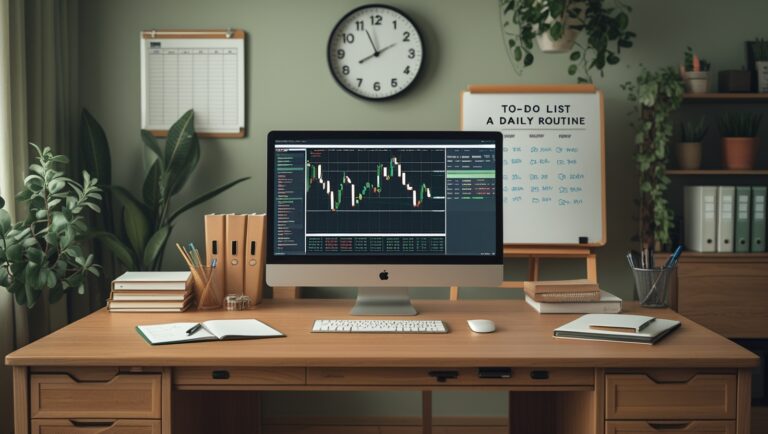How to Use Support and Resistance Levels to Make Better Trades
How to Use Support and Resistance Levels to Make Better Trades
Understanding support and resistance levels is one of the most important skills for traders, especially beginners. These levels help identify key price points where stocks are likely to reverse or continue trends. In this guide, I’ll share how I use support and resistance to make better trades, the strategies I apply daily, and how you can combine them with tools like TradingView and my system to generate consistent monthly income.

Table of Contents
What Are Support and Resistance Levels?
Support is a price level where a stock tends to stop falling and bounce back, while resistance is where it tends to stop rising and reverse.
These levels act like invisible barriers that guide my trade entries, exits, and stop placements.
Step 1: Identify Key Levels on Your Charts
I start by spotting previous highs and lows on a stock’s chart.
Using TradingView, I can quickly mark support and resistance levels and set alerts for when prices approach them: https://www.tradingview.com/?aff_id=155687
Step 2: Confirm Levels With Volume
High trading volume near support or resistance increases the reliability of these levels.
I look for clusters of trades and strong price reactions, which help me identify key areas for potential entries or exits.
Step 3: Combine With Technical Indicators
Support and resistance work best when combined with indicators like RSI, MACD, and moving averages.
For example, a stock hitting support while RSI shows oversold conditions often signals a high-probability buy setup.
Step 4: Plan Your Trades Around Levels
I use support and resistance levels to plan entry points, stop-loss orders, and profit targets.
This structure allows me to trade with confidence and minimize risk, even as a beginner.
Step 5: Track Performance and Refine
Logging trades helps me see how support and resistance levels behave in different market conditions.
Over time, this process improves my ability to identify high-probability setups and avoid low-quality trades.
Step 6: Combine Levels With My Trading System
Indicators and levels alone aren’t enough. I integrate support and resistance analysis with my system from How I Pay My Bills Monthly With Stocks to turn setups into real monthly income.
This approach ensures I consistently make smarter trades and manage risk effectively.
Getting Started Today
Start by marking key support and resistance levels on your charts. Use alerts, combine levels with indicators, and track your trades in a journal.
Using TradingView makes this process simple and efficient: https://www.tradingview.com/?aff_id=155687
Mastering support and resistance allows you to trade smarter, make better entries, and generate consistent profits, even with minimal experience.
When I first started trading, I struggled to understand why stocks bounced at certain price points. Learning support and resistance changed everything for me.
I realized that focusing on key levels allowed me to identify high-probability setups without overcomplicating my charts.
Support levels act like a floor, where buying interest usually steps in, stopping the stock from falling further. Recognizing these levels helps me enter trades confidently.
Resistance levels act like a ceiling, where selling pressure often prevents the price from rising. I use this knowledge to plan profit-taking and exit points.
Using TradingView, I can quickly draw support and resistance lines, monitor price action, and set alerts for key levels: https://www.tradingview.com/?aff_id=155687
I always confirm support and resistance with volume analysis. High volume at a level usually indicates stronger price reactions and more reliable setups.
I combine levels with indicators like RSI, MACD, and moving averages to validate trades. For example, a stock hitting support with an oversold RSI often signals a potential buy opportunity.
I avoid entering trades blindly. Instead, I wait for price action confirmation around support or resistance, such as bullish candlestick patterns or breakouts.
Logging trades is crucial. I track how support and resistance levels perform, which setups worked, and which didn’t, to refine my strategy over time.
I categorize trades based on type, such as bounce trades at support or breakout trades above resistance, which helps me understand which setups are most effective.
Paper trading support and resistance setups first helped me practice identifying high-probability trades without risking real money.
Alerts are essential. Using TradingView, I receive notifications when prices approach my key levels, so I can act quickly without constantly watching charts.
I focus on simplicity. Using only a few well-drawn levels and key indicators prevents chart clutter and helps me make faster, confident trading decisions.
Integrating support and resistance analysis with my system from How I Pay My Bills Monthly With Stocks allows me to turn setups into real monthly income, even as a beginner.
Finally, mastering support and resistance levels lets me trade smarter, manage risk effectively, and generate consistent profits, making it one of the most valuable skills for any trader.
I always check support and resistance levels across multiple timeframes. For example, a support level on the daily chart confirmed by a 1-hour chart bounce increases my confidence in the trade.
I prioritize high-probability setups rather than trying to trade every price movement, which saves time and reduces risk.
Paper trading these levels helped me practice spotting reliable setups without risking real money, building my confidence as a beginner.
I set alerts on TradingView for key support and resistance levels so I don’t have to stare at charts all day: https://www.tradingview.com/?aff_id=155687
Combining alerts, a focused watchlist, and indicators like RSI, MACD, and moving averages ensures I only take trades with the best probability of success.
I log all trades in a journal, noting how support and resistance levels performed and which setups led to profits. This review process helps me refine my strategy.
Finally, combining support and resistance analysis with my system from How I Pay My Bills Monthly With Stocks allows me to trade confidently, protect my capital, and generate consistent monthly income, even as a beginner.

Stay ahead in the stock market! Subscribe to our newsletter and receive exclusive stock flow reports, trading insights, and actionable tips directly in your inbox. Join thousands of traders who get our updates first.







